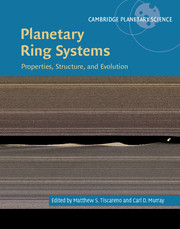Book contents
- Frontmatter
- Contents
- List of Contributors
- Acknowledgements
- I Introductory Material
- II Ring Systems by Location
- III Ring Systems by Type and Topic
- IV Concluding Material
- 19 Future Missions to Planetary Rings
- 20 Planetary Rings and Other Astrophysical Disks
- 21 The Future of Planetary Rings Studies
- Index
- Plate section
- References
21 - The Future of Planetary Rings Studies
from IV - Concluding Material
Published online by Cambridge University Press: 26 February 2018
- Frontmatter
- Contents
- List of Contributors
- Acknowledgements
- I Introductory Material
- II Ring Systems by Location
- III Ring Systems by Type and Topic
- IV Concluding Material
- 19 Future Missions to Planetary Rings
- 20 Planetary Rings and Other Astrophysical Disks
- 21 The Future of Planetary Rings Studies
- Index
- Plate section
- References
Summary
INTRODUCTION
The preceding chapters in this book have provided ample evidence for the growing maturity of planetary ring studies. The wealth of data, particularly from spacecraft observations, has resulted in the discovery of new phenomena and a total reevaluation of our knowledge of ring systems. Therefore, this seems like an appropriate point at which to assess progress and speculate on the future direction of research in this field.
Planetary ring systems are among the most beautiful and iconic structures in the solar system, and continue to play a unique role as vehicles for discovery. This occurs in at least three ways: (i) as detectors of their environment, (ii) as records of the history and origin of their planetary system, and (iii) as natural laboratories for understanding astrophysical disks.
The main rings of each of the giant planets are extensive but delicate systems, with surface areas that are far larger than those of neighboring moons. Therefore, while the surfaces of moons in outer planet systems provide a more permanent record of impacts and internal processes, rings can catch and amplify traces of planetary and interplanetary processes. Transient ejecta clouds provide direct evidence of the population of external impactors (Chapters 3 and 9), and corrugations in the rings of Jupiter and Saturn provide longer-lived records of larger impactors (Chapters 6 and 12). Patterns in dusty rings also give information regarding the nearby planetary magnetic fields (Chapters 12 and 14). Finally, spiral waves in dense rings impart detailed information about the moons that raise them (Chapter 3), and the precession of narrow rings yields some of the most accurate current knowledge of the internal structure of the giant planets (Chapter 11).
Whether rings represent the material left over from the planetary formation process or the debris from a tidally disrupted object, they still provide invaluable evidence of the history and origin of their respective planetary systems. At Uranus, the apparently sourceless ν ring and the closely packed orbits of nearby small moons seem to tell of an eventful history for that planetary system (Chapter 4). Particle mass and size distributions and accompanying spectral data, including local variations across a ring system (see Chapter 3), constrain source materials and evolutionary histories while a proper understanding of all the dynamical processes at work is key to obtaining accurate estimates of the age of a ring system (Chapter 18).
- Type
- Chapter
- Information
- Planetary Ring SystemsProperties, Structure, and Evolution, pp. 577 - 579Publisher: Cambridge University PressPrint publication year: 2018
References
- 1
- Cited by

